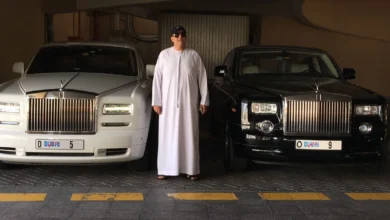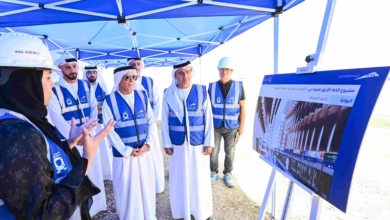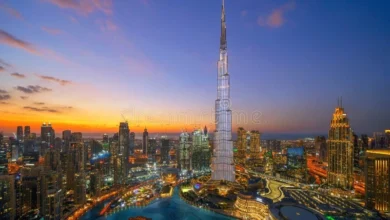
Preserving the Past: How UAE’s Architecture is Honoring Tradition
The United Arab Emirates (UAE) has a rich architectural history that dates back centuries. Traditional Arabic architecture, with its characteristic elements such as courtyards, wind towers, and intricate geometric patterns, has heavily influenced the country’s built environment. This can be seen in iconic structures like the Al Jahili Fort in Abu Dhabi and the Al Fahidi Historical District in Dubai.
In recent years, modernism and contemporary architecture have also made their mark on UAE’s landscape. The nation’s rapid development and economic growth have led to the construction of impressive skyscrapers and innovative designs that showcase cutting-edge technology. However, traditional Arabic influences can still be seen incorporated into these modern structures, creating a unique blend of old and new that is distinctly Emirati.
The Role of Traditional Architecture in the UAE Today
Preserving the cultural identity of a country is crucial in maintaining its unique heritage and traditions. In the UAE, traditional architecture plays a vital role in preserving Emirati culture and reflecting the country’s rich history. Many modern buildings in the UAE incorporate elements of traditional Arabic design, such as mashrabiya screens and arches, to pay homage to their cultural roots.
Traditional architecture also serves as a visual reminder of the past for future generations. The construction methods used by skilled craftsmen centuries ago are still implemented today, keeping alive ancient building techniques that have been passed down through generations.
In addition to preserving cultural identity, traditional architecture also helps maintain cultural and historical continuity. By incorporating elements from previous eras into contemporary designs, architects are able to bridge old with new seamlessly. This creates a sense of connection between present-day society and its past, fostering an appreciation for tradition while embracing progress.
Many historic sites that have been restored or preserved serve as popular tourist destinations in the UAE. These structures not only attract visitors but also provide educational opportunities for people to learn about Emirati history and culture.
traditional architecture plays a significant role in shaping the built environment of the UAE today. It not only preserves Emirati culture but also reflects its evolution over time. From ancient forts to modern skyscrapers adorned with Islamic-inspired motifs, traditional architectural influences continue to leave their mark on this rapidly developing nation.
Challenges in Preserving UAE’s Architectural Heritage
One of the main challenges in preserving UAE’s architectural heritage is the impact of urbanization and rapid development. The country’s economic growth and influx of foreign investment have led to a surge in construction, resulting in the demolition of many historic buildings. As cities expand, smaller traditional structures are often replaced with modern skyscrapers, erasing important pieces of Emirati history.
As new developments take center stage, there is a lack of awareness and appreciation for traditional architecture among both locals and expats. Many people view these older buildings as outdated or irrelevant to their modern lives. This mindset can lead to neglect or even destruction of these valuable cultural assets.
Another challenge is the limited resources available for preservation efforts. While there have been initiatives by government agencies and private organizations to restore historic sites, they often face budget constraints and limited support from the public. Without proper funding and community involvement, it becomes difficult to maintain or protect traditional architectural gems.
Climate change poses a threat to UAE’s architectural heritage. Harsh weather conditions such as high humidity levels and sandstorms can cause damage to delicate materials used in traditional architecture over time. With rising temperatures due to global warming, these threats may become more severe if proper measures are not taken.
While there are numerous challenges facing the preservation of UAE’s architectural heritage, steps must be taken towards its protection for future generations. It requires a collaborative effort between government entities, communities, architects/designers/developers, and individuals alike who recognize its value in maintaining Emirati culture identity.
Efforts and Initiatives in Preserving UAE’s Architectural Heritage
Efforts and initiatives in preserving UAE’s architectural heritage have been undertaken by various entities, including the government and architecture schools and organizations. The UAE government has implemented policies to protect historical sites and promote traditional architecture. For instance, the Dubai Municipality established a Historic Buildings Department in 2011, responsible for identifying and preserving historic buildings in the city.
In addition to policies, the government has also invested in restoration projects of iconic structures such as Al Fahidi Historical District in Dubai. This initiative not only preserves these buildings but also helps revitalize old neighborhoods, making them popular tourist destinations.
Architecture schools and organizations also play a crucial role in promoting traditional Emirati architecture. Many universities offer courses on local architectural styles and techniques, ensuring that future architects are equipped with knowledge about their country’s heritage. These institutions also organize workshops and seminars to raise awareness among students about the importance of preserving traditional architecture.
Numerous non-profit organizations have emerged with a focus on protecting Emirati cultural heritage through conservation efforts. For example, “The Emirates Heritage Club” was established in 1993 with a mission to preserve national identity through safeguarding historical sites.
Some private companies have taken it upon themselves to incorporate elements of traditional Arab architecture into their modern designs as part of corporate social responsibility initiatives. This not only promotes traditional aesthetics but also provides an opportunity for locals to appreciate their cultural roots within their everyday surroundings.
Efforts by different stakeholders are essential for successfully preserving UAE’s architectural heritage. It requires collaboration between governments at all levels – local authorities should work closely with federal agencies – educational institutions, social/cultural groups, and individuals who share a common goal: to maintain Emirati culture identity through its built environment.
Combining Tradition and Modernity: Successful Examples
There have been numerous successful examples of combining traditional and modern architecture in the UAE. One notable project is the rehabilitation and renovation of Al Badiyah Mosque in Fujairah, which dates back to the 15th century. This mosque was restored using traditional techniques and materials, preserving its historical significance while ensuring it remains functional for modern use.
Another example is The Courtyard House in Dubai, a residential project that incorporates traditional elements such as wind towers, courtyards, and mashrabiya screens into its design. These features not only pay homage to Emirati heritage but also serve practical purposes by providing natural ventilation and privacy for residents.
In addition to incorporating traditional elements into contemporary designs, some architects have taken inspiration from Emirati cultural symbols to create unique structures. For instance, the Etihad Museum in Dubai resembles a manuscript with seven columns representing the seven emirates of the UAE. This fusion of tradition and modernity creates an iconic landmark that tells a story about Emirati identity.
Many developers are now recognizing the value of preserving historic buildings while still meeting modern demands. One example is Qasr Al Hosn – Abu Dhabi’s oldest building – which has been transformed into a cultural center while maintaining its original structure and design.
Initiatives like “The Traditional Architecture Revitalization Initiative” (TARI) aim to promote sustainable development through reviving traditional architectural styles. TARI works closely with local communities to preserve their cultural identity by implementing environmentally-friendly practices based on ancient knowledge passed down through generations.
These successful examples demonstrate how combining tradition with modernity can create innovative solutions that not only preserve Emirati culture but also add value to society through sustainable development. By incorporating elements from the past into current designs and promoting awareness among future generations about their country’s rich architectural heritage; we can ensure its preservation for years to come.
Sustainable Preservation: Balancing Economic and Cultural Interests
In recent years, there has been a growing focus on sustainable development in the UAE’s architectural landscape. This involves finding a balance between economic interests and preserving cultural heritage for future generations. With the country’s rapid growth and development, there is a need to find ways to ensure that progress does not come at the cost of losing valuable pieces of Emirati culture.
One way this can be achieved is by involving local communities and businesses in preservation efforts. These groups have an intimate understanding of their surroundings and can provide valuable insights into traditional practices and customs that may otherwise be overlooked. By engaging with them, architects and developers can incorporate these elements into their designs, creating spaces that honor both modern needs and cultural identity.
Involving local businesses in preservation efforts provides economic benefits as well. It creates opportunities for these enterprises to showcase their products or services while supporting initiatives that promote sustainability and preserve Emirati heritage. This collaboration also helps foster a sense of pride among locals about their culture, leading to increased support for preservation efforts.
Another aspect of sustainable development in the UAE’s architectural landscape is promoting environmentally-friendly practices. The country faces challenges such as water scarcity due to its desert climate; therefore it is crucial to find ways to conserve resources while still meeting modern demands for infrastructure.
Many traditional buildings have design features that are inherently sustainable – such as wind towers for natural ventilation – which could serve as inspiration for modern construction methods. By reviving these techniques through restoration projects or incorporating them into contemporary designs, we can learn from our past while building towards a more sustainable future.
Promoting eco-tourism through showcasing traditional architecture also has economic benefits while contributing towards conservation efforts. Many tourists are drawn to authentic cultural experiences when visiting foreign countries; therefore highlighting traditional Emirati architecture can attract visitors who want an immersive experience rather than just staying in luxury hotels or shopping malls.
On top of this, Eco-tourism promotes responsible travel practices and can help raise awareness among visitors about the importance of preserving cultural heritage. This creates a cycle of sustainability, where economic growth is achieved while preserving cultural heritage for future generations.
Education and Awareness: Key to Successful Preservation
Education and awareness play a crucial role in successfully preserving traditional Emirati architecture. It is essential to educate the public, especially younger generations, about the value and significance of their cultural heritage. This can be done through various means such as school curriculum, educational programs at museums or historical sites, and community workshops.
By providing opportunities for people to learn about their architectural heritage, they can develop a sense of pride and appreciation towards it. This not only helps in creating a more informed society but also fosters a sense of responsibility towards preserving these structures for future generations.
Promoting traditional architecture through events and celebrations can also raise awareness among locals and tourists alike. For instance, the annual “Sikka Art Fair” in Dubai showcases local artists’ work inspired by Emirati culture – including traditional architectural styles. Such events provide an opportunity for people to engage with their cultural identity while appreciating its beauty.
In addition to educating the public and celebrating tradition; it is also crucial to involve professionals such as architects, engineers, and developers in preservation efforts. By equipping them with knowledge about local traditions and techniques used in traditional architecture; we can ensure that new developments incorporate elements of Emirati culture into their designs rather than erasing them completely.
The government should continue investing resources into research on traditional building methods; materials, and technologies. As technology advances rapidly, it becomes increasingly important to document ancient practices before they are lost forever. These findings could then be incorporated into modern construction techniques, supporting sustainable development while preserving cultural identity.
It is also vital for individuals within the community – both locals and expats -to take an active interest in preserving traditional architecture. This could involve volunteering time or resources towards restoration projects or simply raising awareness among friends, family, and colleagues about its importance. By involving everyone from different backgrounds, this creates a collective effort towards safeguarding Emirati heritage.
Another aspect that contributes significantly to successful preservation efforts is proper documentation. Much of traditional Emirati architecture has been passed down through oral traditions and practices
The preservation of traditional architecture is not only vital for the future of Emirati culture, but it also has wider implications on a global scale. With increasing globalization and homogenization in design and construction practices, preserving unique cultural identities becomes even more crucial.
By showcasing their architectural heritage, the UAE can promote itself as a diverse and culturally rich destination. This not only attracts tourists but also enhances its reputation as a leader in sustainable development. Countries around the world can learn from the UAE’s efforts to balance progress with preserving tradition, making it an example for others to follow.
However, despite these efforts towards preservation; there are still challenges that need to be addressed. One major obstacle is balancing economic interests with conservation efforts. Developers and businesses may prioritize profits over heritage conservation, leading to conflicts between stakeholders.
To tackle this issue effectively, there needs to be open communication between all parties involved – including government bodies responsible for regulating development projects –to find solutions that benefit both economic growth and cultural preservation.
The importance of preserving traditional Emirati architecture cannot be overstated. It plays a significant role in maintaining cultural identity, fosters sustainable development, and promotes responsible tourism. However, this requires collaboration between different sectors within society – including individuals, businesses, government bodies, and professionals. It is our collective responsibility to ensure that future generations can appreciate the beauty and significance of traditional Emirati architecture while building towards a better tomorrow.






